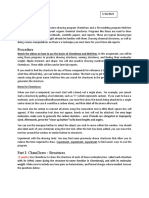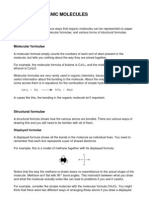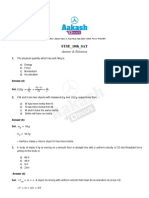Molecmod Lab
Molecmod Lab
Uploaded by
raym6270Copyright:
Available Formats
Molecmod Lab
Molecmod Lab
Uploaded by
raym6270Copyright
Available Formats
Share this document
Did you find this document useful?
Is this content inappropriate?
Copyright:
Available Formats
Molecmod Lab
Molecmod Lab
Uploaded by
raym6270Copyright:
Available Formats
Molecular Model Building
Name Date Class Period
Introduction
A group of atoms held together by covalent bonds is called a molecule. Although we represent molecules on paper as being two-
dimensional for convenience, they are actually three-dimensional. By building molecular models, chemists come to understand
the bonding, shapes, and polarity of even the most complex molecules. A molecule can be represented on paper by either a
molecular or a structural formula. A molecular formula indicates the number and kind of each atom present in a molecule. Some
familiar molecular formulas are shown below.
NH3 CH4
The molecular formulas do not provide any information concerning the actual arrangement of atoms in a molecule. Such
information is given by structural formulas such as the following.
These structural formulas are two dimensional. The angles shown are not true to the shape of the molecule. Structural formulas
can be made to convey more information by using the following symbolism.
Using this symbolism, the structural formulas shown above can be redrawn in the following fashion.
H H
N
H H C
H
H H
Model Building Page 1
In this experiment, you will construct three-dimensional models to help you visualize the shapes of molecules.
You will use ball-and-stick type models, in which colored plastic balls represent atoms and short plastic connectors
represent the bonds. Double and triple bonds are represented by thin flexible connectors and thick in-flexible
connectors serve as single bonds. The plastic balls have holes molded into them to accept the connectors. The
number of holes in the ball represents the maximum number of bonds that a given atom can have. The balls are color-
coded so that atoms of different elements can be distinguished. A typical system is shown in the table below.
Atom Symbol Color Number of Holes
Hydrogen H White 1
Carbon C Black 4
Oxygen O Red 2
Nitrogen N Blue 3
Chlorine (Halogens) Cl Green 1
Sulfur S Yellow 2 or 6
VSEPR Theory
In reality, molecules exist in three dimensions. The Valence-Shell Electron-Pair Repulsion theory, or VSEPR
theory, explains and predicts these three dimensional shapes. The theory states that because electron pairs repel (both
have negative charge), molecules adjust their shapes so that the valence-electron pairs are as far apart as possible.
There are several basic shapes that are then developed by small molecules (no more than several atoms) and these
basic shapes are shown below. As you build the molecules in this lab activity, you may refer to these diagrams to
assist you in identifying the shape of each molecule made.
Model Building Page 2
Name Formula Structural Shape (name)
representation
(As shown on page 1)
1) hydrogen (molecular) H2
2) water H2O
3) methane CH4
4) chlorine (molecular) Cl2
5) ammonia NH3
6) nitrogen (molecular) N2
7) ethyne C2H2
8) phosphorus pentachloride PCl5
Model Building Page 3
9) dichloromethane CH2Cl2
10) 1-propanol C3H7OH
11) carbon dioxide CO2
12) methanol CH3OH This molecule is more complex than
the basic shapes shown in these lab instructions
13) hydrogen peroxide H2O2
14) oxygen (molecular) O2
15) hydrogen sulfide H2S
Model Building Page 4
16) ethene C2H4 This molecule is more complex than
the basic shapes shown in these lab instructions
17) propane C3H8 This molecule is more complex than
the basic shapes shown in these lab instructions
18) propene C3H4 This molecule is more complex than
the basic shapes shown in these lab instructions
19) ethanol C2H5OH This molecule is more complex than
the basic shapes shown in these lab instructions
20) methylamine CH3NH2 This molecule is more complex than
the basic shapes shown in these lab instructions
21) sulfur hexafluoride SF6
22) ethanoic acid CH3COOH This molecule is more complex than
the basic shapes shown in these lab instructions
Model Building Page 5
Isomerism
Structural isomerism
23) Construct a model of butane, C4H10. Draw a sketch of this molecule. Can you construct a model of a different
molecule having the same molecular formula as butane? Structural isomers are two or more chemical compounds
with the same chemical formulae but different structural formulae or different spatial arrangements of atoms. The
different forms are known as isomers. This type of structural isomer differs in the location of a functional group.
The functional group that is switched around in this molecule is a -CH3 called a “methyl group.”
Draw both structures
n-butane (normal butane) Iso-butane
Straight chain molecule Branched chain molecule
24) Another type of structural isomer results in compounds with different types of functional groups. Construct a
model of ethanol, C2H5OH (see number 19 in this lab). Then, construct a model of dimethyl ether, CH3OCH3.
Draw them each below and compare the number of carbons, hydrogens, and oxygens in each.
Draw both structures
ethanol dimethyl ether
Number of C=_______; H=_______; O=_______ Number of C=_______; H=_______; O=_______
These isomers have different physical and chemical properties. Structural isomers play a very important role in
organic chemistry.
Model Building Page 6
Stereoisomerism (Two Types)
Optical Isomerism: Construct a model of bromochlorofluoromethane, CHBrClF. Use a different color ball for
each halogen. Sketch the compound. Construct an isomer of this compound keeping carbon at the center (a different
arrangement of the same atoms)? Hint: Is your left hand identical to your right? Keeping your first model, make
another one that matches it.
25) bromochlorofluoromethane CHBrClF Draw both sets of structures
Optical Isomers Matching molecules
These two compounds have the same molecular formula, CHBrClF, but they are different from each other in the
way that a left hand is different from a right hand. The compounds are mirror-images of each other and have no plane
of symmetry. They are also called chiral molecules – having a central carbon attached to four different groups. The
phenomenon of “handedness” is especially important in biochemistry.
Cis-trans isomerism is another type of stereoisomerism. This occurs when there is restricted rotation about a bond
between two atoms. Groups attached to each atom may be on the same side of the bond (the cis isomer) or opposite
sides (the trans isomer). Cis-trans isomerism also occurs in some inorganic complex compounds, when two groups
may be at adjacent (cis) or opposite (trans) positions.
26) Construct a model of cis-1,2-dichloroethane and another model of trans-1,2-dichloroethane. Both molecules
have the formula C2H2Cl2.
HINT: the carbons are bonded to each other, and each carbon is bonded to one hydrogen and one chlorine.
Draw both structures
Model Building Page 7
You might also like
- Student Study Guide and Solution Manual For Organic Chemistry 4e by David Klein 9 76Document68 pagesStudent Study Guide and Solution Manual For Organic Chemistry 4e by David Klein 9 76MA. FRANCESCA DUCOTNo ratings yet
- CMC Agar Plate RecipeDocument7 pagesCMC Agar Plate RecipeCrystallinjesus100% (1)
- CAPE Unit 2 Chemistry NotesDocument207 pagesCAPE Unit 2 Chemistry NotesAshley Cunningham100% (2)
- Isomerism in Organic Chemistry: Number 93 WWW - Curriculum-Press - Co.ukDocument5 pagesIsomerism in Organic Chemistry: Number 93 WWW - Curriculum-Press - Co.ukslixsterNo ratings yet
- Schaum's Easy Outline of Organic Chemistry, Second EditionFrom EverandSchaum's Easy Outline of Organic Chemistry, Second EditionRating: 3.5 out of 5 stars3.5/5 (2)
- Isomerism in Alkanes, Cycloalkanes, and Alkenes Using Molecular ModelsDocument4 pagesIsomerism in Alkanes, Cycloalkanes, and Alkenes Using Molecular Modelsalbertvdatu278No ratings yet
- Fuel MoleculesDocument3 pagesFuel MoleculesPhillip CookNo ratings yet
- Practical 4Document9 pagesPractical 4KINISHAA A/P TAMIL SELVEN / UPMNo ratings yet
- S1 Gchem Practical Shapes of MoleculesDocument8 pagesS1 Gchem Practical Shapes of MoleculesNorhadi MohamadNo ratings yet
- Practical 3Document8 pagesPractical 3KINISHAA A/P TAMIL SELVEN / UPMNo ratings yet
- Activity 12 ChemDocument13 pagesActivity 12 Chemcheekuk789No ratings yet
- Organic Chemistry Experiment 2Document17 pagesOrganic Chemistry Experiment 2Goh Chun KitNo ratings yet
- Topic 11 - Introduction To Organic ChemistryDocument102 pagesTopic 11 - Introduction To Organic ChemistryMohamad AzzmerNo ratings yet
- 3rd Learning Module_0Document11 pages3rd Learning Module_0manicoleanndNo ratings yet
- Molecular Structures Water and PH LabDocument13 pagesMolecular Structures Water and PH Labapi-249772989No ratings yet
- Neet Chemistry Notes-1Document37 pagesNeet Chemistry Notes-1Abhishek KumarNo ratings yet
- 12.3 Structural Representations of Organic Compounds 12.3.1 Complete, Condensed and Bond-Line Structural FormulasDocument3 pages12.3 Structural Representations of Organic Compounds 12.3.1 Complete, Condensed and Bond-Line Structural FormulaskalloliNo ratings yet
- Genchem5&6sheesh OgDocument5 pagesGenchem5&6sheesh Ogwencylle casilNo ratings yet
- Report 1 Learning Software - Benjamin CruzDocument12 pagesReport 1 Learning Software - Benjamin Cruzapi-674986426No ratings yet
- Chem204 Lecture 1 EnglishDocument32 pagesChem204 Lecture 1 EnglishДууяа Б.No ratings yet
- Ac1 Dominoes Molecules 0910Document3 pagesAc1 Dominoes Molecules 0910Josh PNo ratings yet
- ChemistryDocument166 pagesChemistryjakesidhuNo ratings yet
- Carbohydrates Isomerism ImpDocument20 pagesCarbohydrates Isomerism ImpSurajit BhattacharjeeNo ratings yet
- Stereochemistry (CHEM 2121)Document150 pagesStereochemistry (CHEM 2121)Jasia TasnimNo ratings yet
- StereokimiaDocument73 pagesStereokimiaAdi Kurniawan EffendiNo ratings yet
- IsomerismDocument23 pagesIsomerismAISHAH NAZIRAHNo ratings yet
- 12 Intro To OrganicDocument129 pages12 Intro To OrganicSyamil AdzmanNo ratings yet
- The Chemical Formula: Neil Jozsef C. Macion Kristi Mari N. Montefalcon Maria Angelica Fatima NavarroDocument22 pagesThe Chemical Formula: Neil Jozsef C. Macion Kristi Mari N. Montefalcon Maria Angelica Fatima NavarroDexter EnthusiastsNo ratings yet
- Chemistry - Chang 10th Edition 2Document1 pageChemistry - Chang 10th Edition 2Ayman MurrarNo ratings yet
- Molecular Models5pDocument5 pagesMolecular Models5pAubrey Love LabardaNo ratings yet
- Chemical FormulaDocument29 pagesChemical FormulaGenevee Ryeleen DelfinNo ratings yet
- E4 StereoisomersDocument6 pagesE4 StereoisomersShaun Martel BantuganNo ratings yet
- Structural Formula PDFDocument4 pagesStructural Formula PDFAli AyanNo ratings yet
- Stereo ChemistryDocument17 pagesStereo ChemistryDeepak PradhanNo ratings yet
- 2009 Intro Organic Chem Tutorial (Teachers)Document14 pages2009 Intro Organic Chem Tutorial (Teachers)Tommy Jing Jie NgNo ratings yet
- Organic ChemistryDocument40 pagesOrganic ChemistryGlenda ResultayNo ratings yet
- Unit 10R - CarbohydratesDocument20 pagesUnit 10R - CarbohydratesGovind ManglaniNo ratings yet
- Structural Organic Chemistry. The Shapes of Molecules. Functional GroupsDocument19 pagesStructural Organic Chemistry. The Shapes of Molecules. Functional Groupspatrik710No ratings yet
- Chemistry FormulaDocument29 pagesChemistry FormulaAzalea MercadejasNo ratings yet
- LG 1.5 Isomerism Part II (Stereoisomerism)Document10 pagesLG 1.5 Isomerism Part II (Stereoisomerism)wangmorisNo ratings yet
- Organic Chemistry - Some Basic Principles and Techniques Shobhit NirwanDocument43 pagesOrganic Chemistry - Some Basic Principles and Techniques Shobhit NirwanTanmoy GuptaNo ratings yet
- Isomerism in Coordination CompoundsDocument3 pagesIsomerism in Coordination CompoundsZainab MughalNo ratings yet
- IsomerismDocument29 pagesIsomerismJericho Miles GenteroneNo ratings yet
- UntitledDocument10 pagesUntitledKathrynn NaipaoNo ratings yet
- 10 Organic Hydrocarbons Working DocumentDocument20 pages10 Organic Hydrocarbons Working Documentcheekuk789No ratings yet
- Covalent BondDocument2 pagesCovalent BondOmar ScafeNo ratings yet
- Formulas of Hydrocarbons and IsomersDocument13 pagesFormulas of Hydrocarbons and IsomersJohn Steven Batronel CalaraNo ratings yet
- 1) PPT Developed by NVS TeacherDocument58 pages1) PPT Developed by NVS Teachersugeshkumar123456789No ratings yet
- Molecular Geometry SimlabDocument7 pagesMolecular Geometry SimlabGlexis TiamsonNo ratings yet
- ws13 Stereochemistry Professor Jennifer Poutsma PDFDocument4 pagesws13 Stereochemistry Professor Jennifer Poutsma PDFSankar AdhikariNo ratings yet
- Chemistry LN 2 StereochemistryDocument88 pagesChemistry LN 2 StereochemistryAdnan BukhariNo ratings yet
- 778 Topper 21 101 3 2 38 Organic Chemistry Up201506181308 1434613126 8392Document17 pages778 Topper 21 101 3 2 38 Organic Chemistry Up201506181308 1434613126 8392AMRITHA SINGHNo ratings yet
- Lecture 1 Organic Chemistry Saturated HydrocarbonsDocument90 pagesLecture 1 Organic Chemistry Saturated HydrocarbonsDaryl Joy FRANCISCONo ratings yet
- Stereochemistry: The Two Major Classes of IsomersDocument68 pagesStereochemistry: The Two Major Classes of Isomersanwarhs62100% (1)
- 2024 Introduction To Organic Chemistry Notes (Teacher)Document21 pages2024 Introduction To Organic Chemistry Notes (Teacher)dheekshaNo ratings yet
- Activity 3 Mol GeomDocument11 pagesActivity 3 Mol GeomeeeearllNo ratings yet
- Computational Pharmaceutics: Application of Molecular Modeling in Drug DeliveryFrom EverandComputational Pharmaceutics: Application of Molecular Modeling in Drug DeliveryDefang OuyangNo ratings yet
- The New Chemist Company Publications- Accessible Organic Chemistry: The New Chemist CompanyFrom EverandThe New Chemist Company Publications- Accessible Organic Chemistry: The New Chemist CompanyNo ratings yet
- Agricultural Sciences GR 12 Exam Guidelines 2017 EngDocument22 pagesAgricultural Sciences GR 12 Exam Guidelines 2017 Engraym6270No ratings yet
- Physical Sciences P1 Memo 2021 - 0Document11 pagesPhysical Sciences P1 Memo 2021 - 0raym6270No ratings yet
- Processes in FertilizersDocument1 pageProcesses in Fertilizersraym6270No ratings yet
- 2015 4Document1 page2015 4raym6270No ratings yet
- FC Neurosurg (SA) Intermediate Past Papers - 2016 1st Semester 20-1-2024Document2 pagesFC Neurosurg (SA) Intermediate Past Papers - 2016 1st Semester 20-1-2024raym6270No ratings yet
- Dna Code of LifeDocument25 pagesDna Code of Liferaym6270No ratings yet
- Principles of Heterogeneous Photocatalysis: Photocatalysis: Fundamentals and ApplicationsDocument12 pagesPrinciples of Heterogeneous Photocatalysis: Photocatalysis: Fundamentals and ApplicationsAli HassanNo ratings yet
- STSE ClassDocument29 pagesSTSE ClassNikeNo ratings yet
- 9 - BICH 200-ProteinDocument21 pages9 - BICH 200-ProteinDR. ANUPAMA NAGARAJNo ratings yet
- KDC SSC Pre-076Document12 pagesKDC SSC Pre-076raviNo ratings yet
- Periodic Table Theory - EDocument24 pagesPeriodic Table Theory - EthinkiitNo ratings yet
- Gas Regulators Mix10 y Mix25Document2 pagesGas Regulators Mix10 y Mix25Roberto LeónNo ratings yet
- Low Temperature Cure Strategies For Powder Coatings - IndiaDocument12 pagesLow Temperature Cure Strategies For Powder Coatings - IndiawolfkynNo ratings yet
- The Cell 3Document104 pagesThe Cell 3jandra pearlNo ratings yet
- ITW Product Catalog33 PDFDocument1 pageITW Product Catalog33 PDFjohnNo ratings yet
- Soil Colloids: Clay MineralsDocument16 pagesSoil Colloids: Clay MineralsPeter MukunzaNo ratings yet
- Lipids - Key Points - Sample Past Questions & AnswersDocument14 pagesLipids - Key Points - Sample Past Questions & AnswersAni Favour ChisomNo ratings yet
- 06.11.22_SR.STAR CO-SC(MODEL-A)_Jee_Adv_2018_P2_GTA-4_QPDocument22 pages06.11.22_SR.STAR CO-SC(MODEL-A)_Jee_Adv_2018_P2_GTA-4_QPaminahsimrahsyedNo ratings yet
- Reaction Mechanisms in Environmental Organic ChemistryDocument83 pagesReaction Mechanisms in Environmental Organic ChemistryThanh Vân Trần ThịNo ratings yet
- ASCO 8362 Solenoid Valves Product Data SheetDocument23 pagesASCO 8362 Solenoid Valves Product Data SheetJorge JulianNo ratings yet
- Catch Up Friday March 154Document15 pagesCatch Up Friday March 154Renissa MesinaNo ratings yet
- Jin 1999Document6 pagesJin 1999saitama12343217No ratings yet
- Recent Advances in Fluorescent Probes For Zinc Ions Based On Various Response MechanismsDocument33 pagesRecent Advances in Fluorescent Probes For Zinc Ions Based On Various Response MechanismsWutong DuNo ratings yet
- Andres Anal Chem CalibrationDocument5 pagesAndres Anal Chem CalibrationAndres, Andrea Lyn M.No ratings yet
- Test: StandardDocument9 pagesTest: StandardDaniela CamachoNo ratings yet
- Jurnal Argentometri 2023Document4 pagesJurnal Argentometri 2023monica sebrina SihombingNo ratings yet
- Flame RetardancyDocument32 pagesFlame RetardancyAbbas MithiborwalaNo ratings yet
- Explosive Limits PowderDocument3 pagesExplosive Limits Powderslamet_rNo ratings yet
- Class 11th PCM CET PaperDocument7 pagesClass 11th PCM CET Paperrudrajvshewale007No ratings yet
- Medium Voltage Power Cable Termination and Splicing - For PresentationDocument97 pagesMedium Voltage Power Cable Termination and Splicing - For PresentationCH AsiaNo ratings yet
- Kiln Control Variable OKDocument36 pagesKiln Control Variable OKeng_mhassan1No ratings yet
- USP Monographs - Calcium ChlorideDocument1 pageUSP Monographs - Calcium ChlorideGerónimo PerazzoNo ratings yet
- Plant UtilitiesDocument8 pagesPlant Utilitiestdhyey63No ratings yet
- Chemistry Chapter 8 Manufactured Substances in IndustryDocument24 pagesChemistry Chapter 8 Manufactured Substances in Industrym-9575525No ratings yet
- TDS Pe 010 Uf1820t 04Document2 pagesTDS Pe 010 Uf1820t 04Lenggana SukriaNo ratings yet































































































